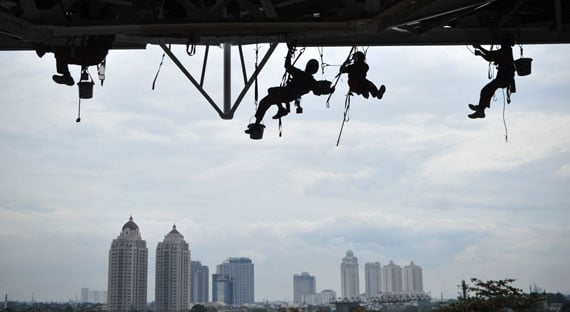
Workers on a construction site in Jakarta, Indonesia, where economic growth is projected to pick up to 5.2% this year (photo: Xinhua/Sipa USA/Newscom).
For Asia, Growth Pickup Provides Opportunity for Reforms
October 13, 2017
Asia continues to lead the global economy with strong growth projected at 5.6 percent this year and 5.5 percent in 2018. The strength of many economies in the region provides an opportunity to pursue key reforms that can amplify and accelerate their beneficial effects, boosting living standards for all, said the IMF in its latest regional assessment.
Related Links
The IMF’s Regional Economic Outlook: October 2017 Update for Asia and Pacific cites strong consumption and investment, as well as better than anticipated external demand as driving the pickup in growth. However, with risks to growth, including rapid credit growth in China, rising protectionism, and geopolitical tensions, policymakers cannot slow the pace of reforms.
“Asia is in a favorable position as growth momentum continues to be strong. It is premature, however, to judge how long this upswing will last. The tailwinds in the region are an opportunity to pass structural reforms and address vulnerabilities,” said Changyong Rhee, Director of the IMF’s Asia and Pacific Department.
Favorable financial climate
Financial conditions in Asia are also favorable thanks to sizeable capital inflows in the first half of 2017.
While the growth outlook has been revised upward, inflation has been marked downward to 2.3 percent in 2017—0.6 percentage points lower than previous projections in April—mainly because of lower commodity prices and appreciated local currencies.
Strong but uneven growth in region
Overall the region’s pickup in growth can be attributed to stronger-than-expected growth in China, Japan, Korea, and countries belonging to the Association of Southeast Asian Nations (ASEAN), which helped compensate for the weaker outlook in Australia and India.
China—the region’s largest economy—is expected to post a growth of 6.8 percent this year, and 6.5 percent next. This year’s upward revision reflects continued strong infrastructure spending and resilience in the real estate sector in the first half of the year. The country has potential to sustain strong growth over the next 3-5 years, but this will require speeding up reforms to make growth less reliant on debt and investment.
India’s growth slowed in recent quarters due to the temporary disruptions from the currency exchange initiative—demonetization— that took place in November 2016, and the recent rollout of the goods and services tax. This tax is a landmark tax reform that should help unify the domestic market and encourage businesses to move from the informal to the formal sector.
Growth in 2017 was revised downward to reflect the recent slowdown, but is expected to accelerate in the medium term as these temporary disruptions fade.
Japan enjoyed growth sustained above-potential for six consecutive quarters through the first half of 2017. The country is expected to grow to 1.5 percent in 2017 driven by a pickup in external demand, as well as consumption supported by fiscal transfers.
Elsewhere, for other countries in Asia and the Pacific, economic prospects remain strong (see table). In particular, the “ASEAN-5” of Indonesia, Malaysia, the Philippines, Singapore, and Thailand are expected to expand by 4.9 percent this year and in 2018. Strong growth in these countries is primarily driven by higher investment and exports.
Outlook: risks and challenges ahead
With strong overall growth for the region, near-term risks to the outlook are broadly balanced. On the plus-side, the cyclical recovery in China and Japan could be stronger and last longer than expected, driven by stronger confidence and more favorable market conditions.
But a sudden tightening in global financial conditions could trigger disruptive capital outflows that would affect particularly those emerging and developing Asian economies and weaken their growth prospects.
A sharp adjustment in China due to unsustainable policies, further increases in debt, and mounting financial imbalances also present risks to the region’s outlook.
Furthermore, as Asian economies are especially vulnerable to protectionism because of their trade openness and integration to global value chains, a global shift toward inward-looking policies could suppress Asia’s exports and reduce foreign direct investment in the region. Escalating geopolitical risks could also negatively impact the region’s medium-term growth prospects.
Additionally, over the longer-term, Asia will need to tackle two key challenges: population aging and lagging productivity growth—a measure of a country’s efficiency. The robust recovery and fiscal space in some countries provide an opportunity to offset the short-term costs and build public support for ambitious structural reforms to tackle the medium-term challenges.
Policies that reinforce growth
Given these challenges, policies should aim to lift incomes, create jobs, and make sure growth is shared by all in the region.
The report notes that the mix of subdued inflation and robust capital inflows to the region provides scope for monetary policies to remain accommodative, while financial sector policies can be tightened to mitigate financial stability risks.
To tackle the region’s longer-term challenges of aging, the report also recommends policies that protect the vulnerable and incentivize the working age population to participate in the labor force.
These include reforms that promote labor force participation of women and the elderly (Japan), and that strengthen pension systems (Thailand).
To boost productivity growth, the report recommends reducing regulatory burdens and promoting competition in the service sector (Korea), and minimizing tax distortions to improve resource allocation to productive firms (Philippines).



